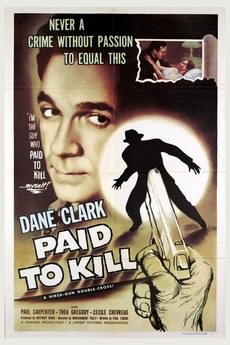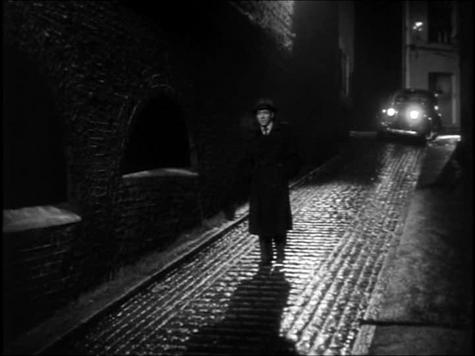Previously I made the assertion that instances of bad luck and, let’s say, poor choices when it comes to decision-making were major ingredients of film noir. I suppose rash decisions can and often do count as poor, so this fatal combination makes another appearance in Paid to Kill (1954), an early Hammer production which followed the formula adhered to by the studio back then of using a slightly faded US star in the lead to add greater marketing appeal outside of the UK.
Jim Nevill (Dane Clark) is a businessman and the head of Amalgamated Industries – I’m not sure if the exact nature of the industries is ever mentioned and if it is, I’ve no memory of it. Anyway, the point is that, despite surface indications, Nevill and his company is in trouble. A deal he had been depending on seems to have fallen through and he’s faced with the prospect of professional and personal ruin. This is an unattractive prospect but it’s made even more unpalatable by the fact that Nevill is desperate to ensure his wife, Andrea (Thea Gregory), is not dragged down with him. This is where we come to the rash decision referred to above – he hires (blackmails actually) an old acquaintance with a shady past to kill him so his wife will benefit from a generous insurance payout. Quite aside from the matter of pushing nobility and altruism to the extreme, Nevill has miscalculated badly. What happens when a man who convinced himself he had nothing to live for then discovers that the opposite is the case after those grinding wheels of fate have been set in relentless motion? What do you do when the man you’ve paid to take your life looks like he’s not only determined to fulfill his side of the bargain but has also dropped completely out of sight?
The Hammer name is best known for the horror movies the studio specialized in from the last 1950s onward but the studio was making a lot of these modest little crime movies in the earlier part of the decade. When it came to marketing them for DVD release some years ago they were labeled as noir, although that didn’t really fit in all cases. Having said that, Paid to Kill does live up to the billing and the whole premise of the movie, along with the tone and look, is pure noir. The focus of this site has remained firmly on British crime of late and certain directors have almost inevitably been featured. Montgomery Tully hasn’t been included until now but his output during the 50s and 60s was such that it would be difficult to run through any short series of articles on this theme without coming to him eventually. His work on Paid to Kill is quietly impressive, maintaining a good pace and an attractively dark look.
Overall, I like this film – the story is melodramatic but in a good way, and the direction has a smooth efficiency – but it would be remiss of me if I were to gloss over the deficiencies. To begin with the positive, I feel Dane Clark did well as the lead, hunted and subdued for the most part but also bouncy and pugnacious when the twists of the plot required it. While he’s not an actor I’ve ever warmed to in particular, I’m happy to acknowledge how important he is to the production here. Yet that’s about it as far as the praise for the acting goes. With the notable and laudable exception of Clark, we’re treated to a succession of overly broad, flat or, in a few cases, outright wooden performances. Disappointing.
Paid to Kill was released on DVD by VCI, paired up on the same disc with another Montgomery Tully effort The Glass Tomb. There’s some print damage to be seen throughout and it’s clear that no restoration was attempted. Still, the image isn’t displeasing and that damage isn’t too distracting. OK, I’ve been quite dismissive of many of the performances but Clark is fine and his work, alongside Tully’s direction and the fatalistic plot, more or less compensates. It’s a neat and compact British noir and a good example of early Hammer.


Got it on the VCI set but not seen it. Hmmm … not encouraging!
LikeLike
By which I mean, doesn’t leap to the top of the pile but definitely want to see it.
LikeLike
I think the movie is generally fine, a standard piece of low budget Brit noir. And it is noir, whereas that’s not always the case in spite of what the marketing departments try to tell us.
But no, I don’t reckon I’d want to advise anyone to push it u to the top of their list of priorities. The plot is enjoyable, if familiar in the territory it covers, and the direction and pacing are pretty good. Still, the acting is not as good as I’d want, Clark excepted, and this definitely pulls it down a few notches in my estimation.
Of course since you have a copy, you should give it a go when you’re in the mood for this kind of film – just adjust your expectations regarding the performances and you’ll probably have a satisfying enough time with it.
LikeLike
I haven’t seen GLASS TOMB either actually so could be a fun double bill 🙂
LikeLike
Yes, go for it! The thing about movies such as these is that these is no huge investment of time required – an hour or thereabouts isn’t much of a commitment and you never know when you might stumble onto something surprisingly entertaining.
LikeLiked by 1 person
Well said that man!
LikeLiked by 1 person
I quite enjoyed this one although, as you say in your reply to Sergio, the plot is a reworking. The earliest version I’ve been able to find of it is Der Mann, Der Seinen Mörder Sucht (1931) but I’m sure there must be earlier ones. Others with the same premise I’ve come across include The Whistler (1944) — perhaps its best-known incarnation? — and The Pretender (1947).
LikeLike
I suppose, John, that when you have a promising setup like this there is the temptation to return to it more than once. his kind of premise is ideal for film noir and I don’t actually mind the comparative lack of freshness. Rashness, betrayal and the caprice of fate makes for a strong and attractive hook but one that is bound to become a bit repetitive after some time.
LikeLike
Couldn’t agree more: it’s a great premise, and my own enjoyment of the movie wasn’t hampered by the familiarity.
LikeLike
The execution of it is engaging enough, which is arguably more important than originality when it comes to movies like these.
LikeLike
The title confused me at first – it was called “FIVE DAYS” originally (and released in the U.S. as ‘Paid In Full’). I saw the film just once, years ago, on UK TV under its original title. I really should look out for it.
I have two other films Clark made in Britain for Hammer in 1952 & 54 and enjoyed those. Back in 1956 the BBC showed a US TV series called “WIRE SERVICE” which starred Dane Clark, Mercedes McCambridge and (a grey-haired) George Brent, each week alternating episodes. That would have been my first intro to Mr. Clark.
LikeLike
Those altered titles can cause a lot of confusion, Jerry. And nearly every British B features seemed to have its name changed!
The film is OK but, as I said above, it’s not what I’d term essential. Clark was a fair actor, good enough in most stuff I’ve seen so far – I just wish I could warm to his screen persona a bit more.
LikeLike
The film is no longer that readily available but I have found a copy (at a sensible price) and ordered it. Thanks for the reminder, Colin.
LikeLike
Some of those VCI doubles have risen in price now. Fortunately, I picked up most when they first came out. Sadly, I missed out on The Unholy Four/The Stranger Came Home, which is now kind of elusive.
LikeLike
Same story with me!
LikeLike
I guess the trick is ‘get ’em while you can’! Some though are notoriously missing altogether, such as “DIAL 999″/”THE WAY OUT” (1955) which does not appear to have had a release at all. By all accounts it is quite a worthwhile film.
LikeLike
Yes, you need to be quick on the draw with some of this stuff. Or hope someone else decides to release them.
Not seen The Way Out/Dial 999 myself – it does indeed appear to be exceptionally rare.
LikeLike
THE WAY OUT/DIAL 999 is pretty good and Gene Nelson is on fine form as a total louse. Another interesting Monty Tully British B. Nice shot,as I recall of Mona Freeman boarding a London Bus for folks who relish that type of thing. Mona appeared in another Brit B SHADOW OF FEAR which is not exactly Hitchcock but provides a chill or two. SHADOW OF FEAR (aka Before I wake) also had an American director…Al Rogell.
Sometimes these Brit B’s also imported Hollywood directors, like TRACK THE MAN DOWN (R.G.Springsteen) and THE MURDER GAME (Sidney Salkow). THE MURDER GAME was one of the last of the American stars in British B flicks genre this one starred Ken Scott who Fox were trying to make something of at the time. THE MURDER GAME played as the support picture to the dire STAGECOACH remake.
The Monty Tully film that I would love to see is MAN IN THE SHADOW (aka Violent Stranger) starring Zachary Scott and Faith Domergue…it’s quite highly regarded but incredibly rare. Anglo Amalgamated the film’s UK distributor had enough faith in the film to top bill it over INVASION OF THE HELL CREATURES as a truly wacky Merton Park meets American International double bill. In America INVASION OF THE HELL CREATURES was titled Invasion of The Saucer Men.
BTW Jack Arnold’s fine modern day Western MAN IN THE SHADOW was title changed to Pay The Devil in the UK…confusing isn’t it!
LikeLike
Even more confusion arose for me just now, John! When you mentioned Shadow of Fear I thought for a moment that I had a copy of that – it sounded familiar. A quick check though tells me that I do own a film of that title, just not the same one. The one I’ve got is also (just to add to the perplexity) a British production, but made in 1963.
LikeLike
My copy of “FIVE DAYS/PAID TO KILL” just arrived. The VCI release now sells for silly prices; the one I have is an Italian release and is very likely a bootleg of the VCI?? Anyway, print quality is OK and probably the same as the one you have, Colin. It has the option of an English soundtrack without subtitles.
Quite looking forward to seeing it again after many years. Thanks for drawing attention.
LikeLike
I hope you like it, Jerry. I’ve no idea how the rights with this film lie in Italy – it can be difficult to determine provenance with material originating from the Hollywood majors as far as the various European markets are concerned, and semi-independent productions like this are even more complicated.
LikeLike